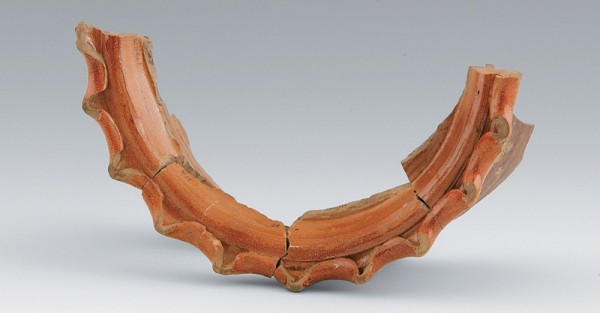
The woman in this early-twentieth-century photograph is making butter in a Langerwehe brown salt-glazed stoneware churn with a scalloped foot. (Courtesy, Töpfereimuseum, Langerwehe, Germany.)

Storage jar or churn fragment, Langerwehe, Germany, probably mid-eighteenth century. Salt-glazed stoneware. H. 5". (Courtesy, Gloucester County; photo, Robert Hunter.)

Base of the vessel fragment illustrated in fig. 2.
The German town of Langerwehe is located between the cities of Aachen and Cologne in Westphalia. Potters, working with local clays, produced a wide variety of lead-glazed earthenware and salt-glazed stoneware vessels beginning in the late twelfth century and continuing through the nineteenth century.[1] Inexpensive, mass-produced glass bottles caused a decline in the demand for stoneware storage vessels and eventually led to the end of commercial production. Langerwehe salt-glazed stoneware vessels were similar in form to those made at other production centers in the Rhineland but usually were undecorated (fig. 1). Most of these plain vessels were sturdy, utilitarian forms.[2]
The Langerwehe vessel found near the Gloucester County courthouse in Virginia is a brown salt-glazed stoneware storage jar or butter churn with a distinctive base pinched to make the pot sit securely on dirt floors (fig. 2). It was wheel thrown with a rounded footring and a base, which is slightly domed on the exterior. A foot rim was added by attaching a projecting band of clay to the bottom of the pot, which was imperfectly smoothed at the joints. The footrim was folded downward and pinched to form a series of somewhat evenly spaced scalloped projections that terminate in points (fig. 3). The entire jug is thinly salt-glazed, the characteristic orange-peel texture of which is most apparent on the interior surfaces. The uniformity of the interior glazed surfaces suggests that the pot had a wide rim that allowed the salt glaze to adhere evenly. The interior and exterior surfaces were smoothed before firing but still show some potting rings and fingermarks.
Archaeologist Douglas Sanford, director of the former Gloucester County Archaeology Project, recovered the fragmented vessel in 1976. He found primarily base fragments within a mid- to late-eighteenth-century archaeological context associated with the destruction of a building located in close proximity to the courthouse.[3] In the early nineteenth century the context was impacted by the construction of a debtors’ jail. Initial interpretation of the complex of features found beneath and to the west of the jail leaned toward a tavern or ordinary—perhaps the building marked “Ordinary” or “Clubhouse” on, respectively, the 1754 and 1774 plats of the courthouse area. This establishment served people on court days as well as travelers passing through along “the great roade,” the primary thoroughfare in the county.
German storage jars of this type are virtually unrecorded in Chesapeake archaeological sites, and this vessel represents a unique specimen of this medieval form in a mid-eighteenth-century Virginia context. However, Martha Zierden, Curator of Historical Archaeology at the Charleston Museum in South Carolina, reports the recovery of a similar jar from the James Stobo plantation (1741–1767) at Willtown.[4] It is hoped that, with the publication of this specimen from Gloucester, Virginia, other examples from American sites will be recognized.
William Pittman, David Brown, and Thane Harpole, Fairfield Foundation, Gloucester, Virginia
Fairfield@inna.net
David R. M. Gaimster with Robin Hildyard, German Stoneware, 1200–1900: Archaeology and Cultural History, Containing a Guide to the Collections of the British Museum, Victoria & Albert Museum, and Museum of London (London: British Museum Press, 1997).
The Töpfereimuseum (Pottery Museum) in Langerwehe, which displays several jugs with the identical scalloped foot, states that these storage jars were used extensively to store such foods as honey, eggs, and sauerkraut.
David Brown, “The Curation and Archaeological Assessment of the Gloucester County Archaeological Project (GCAP),” Gloucester Historical Committee, 2001, p. 13 and Appendix A.
Martha Zierden, Suzanne Linder, and Ronald Anthony, Willtown: An Archaeological and Historical Perspective, Archaeological Contributions 27 (Columbia: South Carolina Department of Archives and History, 1999), p. 205.
